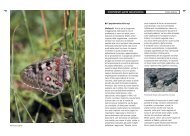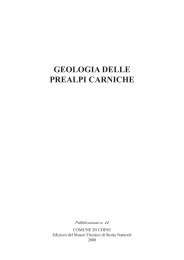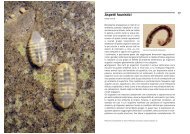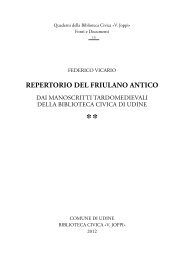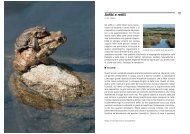Despite its inhospitable appearance and lack of any ... - Udine Cultura
Despite its inhospitable appearance and lack of any ... - Udine Cultura
Despite its inhospitable appearance and lack of any ... - Udine Cultura
Create successful ePaper yourself
Turn your PDF publications into a flip-book with our unique Google optimized e-Paper software.
76<br />
aquifers in the Sabini mountains <strong>and</strong> in<br />
karstic water in Cilento <strong>and</strong> evaporites<br />
in Calabria as well). These recent<br />
populations settled where palaeoendemics<br />
were already living <strong>and</strong><br />
characterised Apennine areas. Thus,<br />
groundwater percolating in Triassic<br />
evaporites in Emilia hosts Niphargus<br />
poianoi; the karstic systems <strong>of</strong> the<br />
Aurunci, Gran Sasso <strong>and</strong> Alburni<br />
ranges are inhabited by the<br />
extraordinary copepod Acanthocyclops<br />
Stygiomysis hidruntina (ca. 2x)<br />
agamus <strong>and</strong> species <strong>of</strong> the genus<br />
Pseudectinosoma, which are perhaps<br />
Messinian relict. As regards gastropods, the genera Alzoniella, Avenionia <strong>and</strong><br />
Fissuria live in the northern Apennines, <strong>and</strong> Arganiella, Orientalina <strong>and</strong><br />
Pauluccinella in the central Apennines; the genus Islamia is divided into<br />
northern <strong>and</strong> central-southern species.<br />
Apulian province. Apulian groundwater is clearly different from that <strong>of</strong> the<br />
Apennines, <strong>and</strong> is rich in specialised endemics, especially in <strong>of</strong>ten brackish,<br />
saturated, karstic habitats. This is due to the extent <strong>and</strong> ancient origin <strong>of</strong><br />
karstification, as well as to the geological history <strong>of</strong> Apulia, which palaeogeographers<br />
consider as part <strong>of</strong> a different tectonic micro-plate from those<br />
that shaped the Italian peninsula. These waters host exceptional specialised<br />
organisms <strong>of</strong> marine origin, like the sponge Higginsia ciccaresei, the<br />
gastropod Salenthydrobia ferrerii, the ostracods Trapezic<strong>and</strong>ona stammeri<br />
<strong>and</strong> Pseudolimnocythere hypogea, the thermosbaenacean Monodella<br />
stygicola, the extraordinary metaingolfiellid amphipod Metaingolfiella<br />
mirabilis, the hadziid amphipod Hadzia minuta, the salentinellid Salentinella<br />
gracillima, mysids <strong>of</strong> the genera Spelaeomysis <strong>and</strong> Stygiomysis, <strong>and</strong> the large<br />
decapod Typhlocaris salentina.<br />
Tyrrhenian <strong>and</strong> Sardinian provinces. This province includes Sardinia, part <strong>of</strong><br />
the Tuscan archipelago <strong>and</strong> isolated coastal areas in Italy deriving from the<br />
fragmentation <strong>of</strong> the Tyrrhenid, which started in the Oligocene. Palaeo-<br />
Tyrrhenian endemics are phylogenetically similar to evolutionary lines in the<br />
areas <strong>of</strong> Provence, the Pyrenees <strong>and</strong> Corsica. Among the several Sardinian<br />
endemics, the gastropod genera Sardhoratia <strong>and</strong> Sardopaladilhia, m<strong>any</strong><br />
species <strong>of</strong> cyclopoid <strong>and</strong> harpacticoid copepods, the bathynellacean<br />
Sardobathynella, the entire phyletic line <strong>of</strong> isopods related to Proasellus patrizii,<br />
<strong>and</strong> isopods <strong>of</strong> the genus Stenasellus, are also found along the Tuscan coast.<br />
Also presumably <strong>of</strong> palaeo-Tyrrhenian origin are the thermosbenacean<br />
Tethysbaena argentarii <strong>of</strong> Mount Argentario (Tusc<strong>any</strong>) <strong>and</strong> the amphipod<br />
Metacrangonyx ilvanus <strong>of</strong> the isl<strong>and</strong> <strong>of</strong> Elba. Other animals associated with local<br />
anchialine water are m<strong>any</strong> amphipods <strong>of</strong> marine origin <strong>of</strong> the genera Bogidiella<br />
<strong>and</strong> Pseudoniphargus, <strong>and</strong> the subgenus Thyrrenidiella <strong>of</strong> genus Ingolfiella.<br />
More doubtful are the relationships between some gammarid genera, like<br />
Longigammarus, Tyrrhenogammarus, <strong>and</strong> the puzzling Ilvanella.<br />
Iblean province (Sicily). Sicilian stygobionts are biogeographically composite<br />
<strong>and</strong> little known, especially those living in the alluvial plains <strong>and</strong> karstic<br />
aquifers that sometimes develop in chalk. Clearly identified organisms are<br />
found in the Iblean area, especially in the water-table <strong>of</strong> the karstic system<br />
near Porto Palo. Although this small area is jeopardised by man-made<br />
alterations, exceptional, perhaps palaeo-Mediterranean endemics inhabit it,<br />
like the thermosbaenacean Tethysbaena syracusae, the cirolanid isopod<br />
Typhlocirolana aff. moraguesi, <strong>and</strong> the amphipods Tyrrhenogammarus<br />
catacumbae <strong>and</strong> Pseudoniphargus duplus.<br />
Examples <strong>of</strong> distribution <strong>of</strong> endemic stygobiont species; left: gastropods <strong>of</strong> the genus Paladilhiopsis<br />
(Eastern Pre-Alps, red circles) <strong>and</strong> Arganiella (Apennines, green circles); right: crustaceans <strong>of</strong> genera<br />
Stenasellus (Tyrrhenian, red circles), Spelaeomysis (Apulia, blue circles) <strong>and</strong> Tyrrhenogammarus<br />
(T. catacumbae, Iblean Mts, Sicily, green circles)<br />
77




